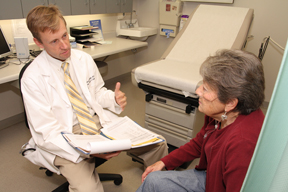A recent article authored by UAB Professor Emeritus Dick Briggs Jr., M.D., suggests chronic obstructive pulmonary disease (COPD) is increasing in prevalence and mortality, especially among women, and will be the third leading cause of death in the world by 2020.
 |
| Mark Dransfield, assistant medical director of the Lung Health Center, is pushing for an earlier, broad-based and aggressive approach to management of chronic obstructive pulmonary disease (COPD) in primary-care settings. |
“The increasing incidence of COPD worldwide is due to the increasing prevalence of cigarette smoking in the developing world and Asia,” Dransfield says. “Although fewer Americans are smoking now compared to the 1970s, we are just seeing the peak effects of the prior popularity of the habit.”
COPD is a lung disease commonly caused by smoking in which the lungs are damaged, making it hard to breathe. The disease can be treated, but cannot be cured. In COPD, the airways — the tubes that carry air in and out of your lungs — are partly obstructed, making it difficult to get air in and out.
Most people with COPD are smokers or former smokers. Breathing in other kinds of lung irritants like pollution, dust, or chemicals over a long period of time also may cause or contribute to COPD.
UAB is positioning itself as a leader in diagnosing and treating the disease, and numerous faculty and staff in the Lung Health Center are researching ways to effectively combat the disease.
“UAB is involved in multiple large clinical trials of COPD, including both National Institutes of Health and pharmaceutical-sponsored trials,” Dransfield says. “These range from Phase I and II pilot studies to large-scale randomized trials to assess clinical efficacy of new and existing therapies. At present, 12 such trials are ongoing through the Lung Health Center, and recruitment is continuous. UAB is viewed as a national leader in both the clinical care of COPD patients and patient-based research.”
Under diagnosis an issue
Part of the trouble for patients is that the disease is under-diagnosed and therefore not properly treated. Dransfield says this happens for multiple reasons, including the belief that cough, sputum production and shortness of breath are normal for smokers.
“In addition, many physicians view COPD as a self-inflicted disease with few effective therapies and are thus not enthusiastic about testing for airflow obstruction,” Dransfield says. “Simple spirometry, or measurement of lung function, is all that is required to diagnose the disease, but it is underutilized.”
The lung-function test known as FEV1 has long been considered the best way to monitor the progressive illness, but Dransfield says in his American Journal article this practice is outdated and likely compromises patient care.
Dransfield wants an earlier, broad-based and aggressive approach to management in primary-care settings.
“FEV1 correlates poorly with patient symptoms and quality of life, and therapies can be effective even in the absence of FEV1 changes,” Dransfield says. “The impact of COPD is better assessed by multi-dimensional indices, including lung function, severity of dyspnea, exercise capacity and body-mass index.”
Since there is no cure for the disease, those with COPD — especially smokers — have to alter their lifestyle to improve their conditions.
The major intervention proven to affect the natural history of the disease is smoking-cessation and inhaled medications can improve symptoms and quality of life.
Pulmonary rehabilitation also is a very effective intervention to improve patients’ symptoms, but Dransfield says it is underutilized.
Several critical clinical trials have recently been completed, and there is hope the results will provide clues to help combat the disease.
“We hope they will show that inhaled therapies can delay the decline in lung function associated with COPD,” Dransfield says.
Visit www.uab.edu/lunghealthcenter for more information on COPD and other lung-related diseases.